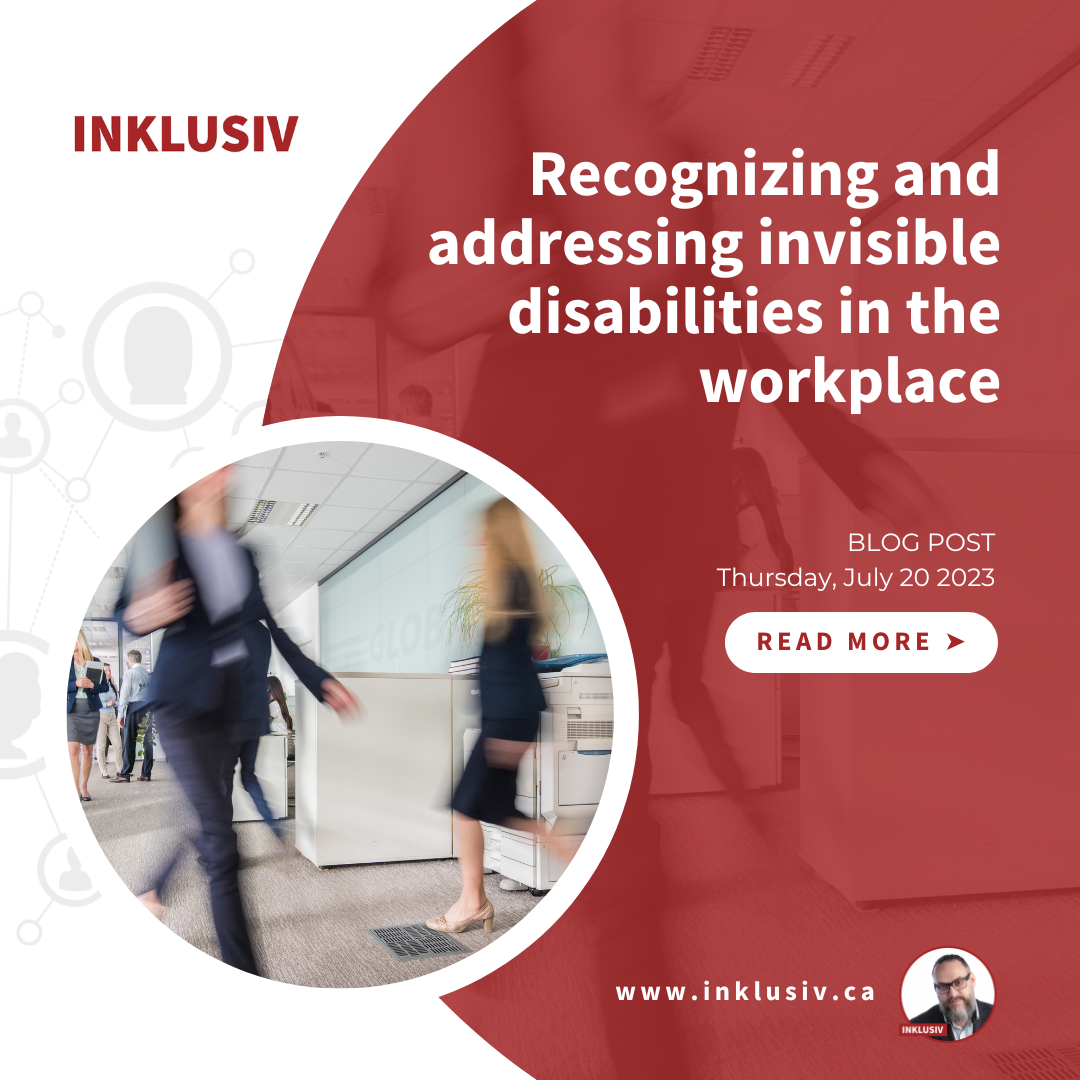Recognizing and addressing invisible disabilities in the workplace

Imagine a vibrant, bustling workplace. You see a flurry of activity: colleagues hustling between meetings, clusters of teammates collaborating on projects, some on the phone or Zoom calls, others typing away at their desks. It’s a typical office scene depicting motivation, engagement, and a collective pursuit of organizational goals.
But… what if, beneath your surface-level observation, was a deeper, more complex reality? What if some of the most significant challenges faced by folks in that workplace were the ones that you couldn’t even see?
Welcome to the silent world of invisible disabilities. A realm where physical, mental, or neurological conditions don’t necessarily manifest themselves in noticeable physical impairments, but significantly impact the daily lives of your team members nonetheless. Often referred to as “hidden disabilities,” invisible disabilities include conditions such as ADHD, autism, chronic pain, traumatic brain injuries, post-traumatic stress disorders, anxiety, depression, dyslexia, and many more.
Typically overlooked and misunderstood due to their hidden nature, these disabilities still pose very real challenges in productivity, engagement, and overall well-being for the individuals involved.
A silent minority in the workplace
Unlike visible disabilities that are, by definition, much more noticeable, the conditions of these individuals often go unrecognized because they don’t manifest in physically apparent ways, making them that much easier to overlook or misunderstand. This leads to countless unfortunate situations of discrimination, stigma, and exclusion in the workplace.
With research suggesting that 80% of all disabilities are invisible, as an organization leader, it’s critical for you to realize that folks dealing with these hidden disabilities represent a silent minority that usually goes largely unrecognized. The sheer invisibility of these conditions makes it too easy for leaders and colleagues to overlook them.
This leads to misunderstandings, miscommunications, or even unintentional exclusion and stigma! The problem is much bigger than just diversity and inclusion, as the challenges faced by this silent minority directly get in the way of the broader goal of creating a conducive, supportive, and empathetic work environment. Despite their invisible nature, these conditions can impose substantial hurdles in the workplace, affecting not only individual performance but also collective productivity and the overall health of the organization.
Consider Judith, an employee grappling with chronic pain, a condition that might not be immediately evident to others. This persistent discomfort could make tasks requiring physical endurance a genuine struggle. For instance, on-site inspections or extended periods of standing could exacerbate her pain, leading to decreased productivity and potentially more sick days.
Now imagine Miguel, a colleague with ADHD, a neurodevelopmental disorder that affects attention and impulse control. In a workplace context, Miguel might find it challenging to stay focused during long meetings or manage tasks requiring extended concentration. This could result in missed deadlines, overlooked details, and even lower morale as he struggles to meet expectations.
Additionally, consider an individual like Myriam, who deals with severe social anxiety, a disorder characterized by an intense fear of social situations. Networking events, team-building activities, or even casual office banter could be incredibly daunting for her, potentially leading to feelings of exclusion or distress. She may avoid participating fully in such events, thereby missing opportunities for personal and professional development.
These three simple examples illustrate how invisible disabilities can pose tangible obstacles in the workplace, impacting job performance, productivity, and overall well-being. While these disabilities may not be physically noticeable, their effects on individuals and teams are real and significant, highlighting the need for recognition, understanding, and appropriate accommodations. Recognizing and understanding invisible disabilities is one of the very first steps towards addressing them.
As a leader, you must recognize that the productivity, engagement, and overall well-being of your team members with invisible disabilities are critical factors that directly influence the collective success of your team and the broader organization.
By approaching this issue with open minds and hearts, you have the opportunity to create strategic interventions that can turn these challenges into opportunities that can then foster inclusion, resilience, and, ultimately, the growth and success of a more diverse and successful organization. What strategies might you put into practice to help your silent minority thrive?
Strategies for addressing invisible disabilities
Recognizing and addressing invisible disabilities in the workplace requires both a shift in understanding and a willingness to adapt. It starts with creating an environment that encourages open dialogues about disabilities without fear of stigma or repercussions. Here are five strategies that will go a long way toward facilitating such a change.
- Flexible work arrangements: Traditional work schedules or settings may not suit everyone, especially those managing invisible disabilities. Allowing for flexible work hours or work-from-home opportunities can be beneficial. For instance, Judith, who is dealing with chronic pain, may find it more comfortable to work from home where she can manage her condition better. Alternatively, someone with ADHD, like Sanjay, might perform better with a schedule that allows for regular breaks. By demonstrating flexibility, leaders can accommodate the unique needs of these employees and foster an inclusive environment that values productivity over presence.
- Accommodating workspaces: Similarly, minor changes to the physical workspace can significantly help individuals with invisible disabilities. Providing a quiet room or noise-cancelling headphones can assist those with sensory sensitivities or ADHD by reducing distractions. For employees dealing with chronic pain, ergonomic furniture or opportunities for regular movement can mitigate discomfort. Accommodating workspaces is a tangible step toward recognizing and addressing the needs of employees who have invisible disabilities.
- Mental health support: It’s an increasingly recognized fact that invisible disabilities often intersect with mental health issues. Offering employee assistance programs that include mental health services likely provides valuable support for those who require it. Additionally, regular check-ins about employees’ well-being show that, as a leader, you value their mental health. Promote and normalize this mindset by encouraging them to take advantage of these support services when needed. This proactive approach will help alleviate the mental health challenges often associated with invisible disabilities.
- Training and awareness programs: Ignorance can very quickly lead to misunderstanding and stigma. Regular training sessions can educate employees about invisible disabilities, contributing to a culture of empathy and understanding. Through workshops, employees can learn about the challenges their colleagues might be facing and how to offer proper, adequate, and respectful support. Awareness programs can also help dispel any misconceptions and reduce the stigma surrounding invisible disabilities.
- Inclusive policies and practices: Formulating inclusive policies that recognize and accommodate invisible disabilities is another crucial aspect of a fruitful strategy. This could involve modifying performance evaluation criteria, offering longer breaks, or incorporating accessibility features in company software. Additionally, practices such as inclusive recruitment, where job descriptions, interviews, and selection processes are designed to be accessible, will also go a long way towards helping individuals with invisible disabilities feel valued and included.
As an added or collateral benefit, implementing strategies such as the ones identified above will not only support individuals with invisible disabilities – it will also enhance the overall work environment, leading to a more diverse, inclusive, and productive workplace.
Indeed, invisible disabilities may be silent and harder to notice, but they don’t have to be ignored or overlooked! Make it a point to recognize and address these hidden challenges, and as leaders, you will create a more inclusive, productive, and successful workplace. Remember, every challenge that you and your team overcome is a step towards success, and in acknowledging the silent minority, what we are doing is acknowledging the vast potential within our diverse workforce.

About Denis Boudreau
Denis Boudreau is a consultant, trainer, coach, and speaker specializing in inclusive leadership and inclusive communication. He works with leaders and executives who are no longer willing to overlook disability inclusion and want to transform their leadership approach from “inclusive-ish” to truly inclusive by championing accessibility. A Certified Professional in Web Accessibility (CPWA), Denis has trained thousands of professionals over the past two decades and has delivered hundreds of workshops worldwide in both English and French. He has helped leading brands like Netflix, Salesforce, Victoria’s Secret, and many more embed disability inclusion into their business strategies, empowering them to break down barriers and create deeper, more meaningful connections with their target audiences while also meeting legal obligations.